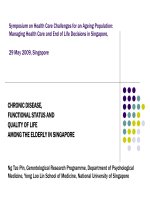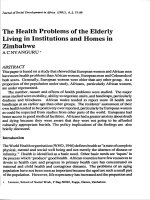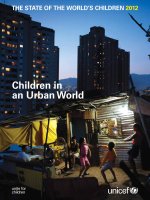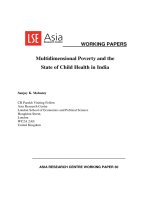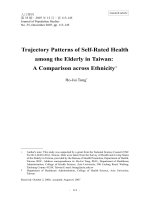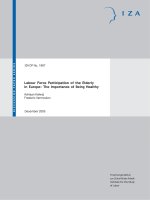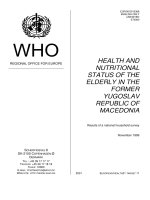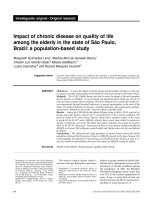State of the Elderly in Singapore 2008/2009 potx
Bạn đang xem bản rút gọn của tài liệu. Xem và tải ngay bản đầy đủ của tài liệu tại đây (975.27 KB, 39 trang )
- 1 -
State of the Elderly in
Singapore
2008/2009
Release 3:
Social Well-being
Going Forward
- 2 -
Contents
Chapter 4 Social Well-being 4
A. Ageing in Place 4
Living Arrangements 5
Living Arrangements of Elderly in the Community 5
Present and Preferred Social Living Arrangements 7
Physical Proximity to Married Child 8
Households Headed by Elderly 9
Programmes and Services for Ageing- in-Place 11
B. Active Ageing 13
Participation in Work 13
Participation in Family 13
Frequency of Visits by Non-Coresident Married Children 17
Frequency of Talking to Non-Coresident Children 18
Frequency of Meeting with Friends 19
Sources of Help 20
Elder Abuse and Neglect 20
Sports Participation 21
Elderly and the Community 22
Sense of Belonging to Town/Estate 24
Participation in Community 26
Volunteerism 28
Interest and involvement in Learning 28
Perception of Wellbeing 29
- 3 -
Active Ageing Index 30
Programmes and Services for Active Ageing 31
Chapter 5 Going Forward 32
The Elderly in 2030 32
The Near-Old 33
Suggestions for Further Research 33
Role of the family 33
Age-Friendly Cities (WHO Project) 34
Centenarians 34
Annex 35
Construction of the Active Ageing Index 35
- 4 -
Chapter 4 Social Well-being
This chapter is divided into two sections: Ageing in Place and Active Ageing. Together, they
provide a measure of the Singaporean elderly’s social integration or well-being. Indicators
of ageing in place include those physical and social factors that enable an elderly to live an
active life in the community. It also looks at the availability of social services for the elderly.
On the other hand, there will be a minority who have been or are committed to institutional
living arrangements such as sheltered and nursing homes. Where available, a profile of
these residents and the reasons for their institutionalisation would be useful as well.
Indicators of active ageing include participation in formal as well as informal organisations
and groupings. Another aspect is participation in family/household activities. Reasons for
non-participation are also important – they point to possible remedial action that could be
taken to encourage/promote participation and ultimately active ageing.
A. Ageing in Place
“Ageing in place” is a concept that has differing interpretations. For some, it refers to the
elderly being able to live in the community in their own homes without ever having to move
while for others, it involves a move to a community home, such as assisted living facilities or
continuing care retirement communities (CCRCs) that provide for the changing health and
housing needs over time [see, for example,
It is the
former idea that Singapore is advocating although the latter should also not be ruled out as
the demographic changes proceed apace.
Singapore’s conceptualisation of ageing in place involves developing strong social networks
involving families and friends and providing care and social services so that the elderly can
continue to live in the community for as long as possible without institutionalisation.
According to the CAI, “’Ageing-in-place’ refers to growing old in the home, community and
environment that one is familiar with, with minimal change or disruption to one’s lives and
activities. This is to promote social integration where the needs of seniors can be met
within the community, rather than to segregate them as a distinct and separate
population”
1
. Ageing in place also involves seniors being able to live with or near their
children, and in this regard, various schemes such as the CPF Housing Grant Scheme and the
1
Report on the Ageing Population, Chapter 3 p 16
(
- 5 -
Married Child Priority Scheme have been put in place
2
. The CAI also considered the option
of retirement villages but it was felt that this should be left to private sector developers
although government is helping with shorter land lease to ameliorate the cost of such
developments. The CAI concurred with the IMC that institutionalisation should be a last
resort
3
.
Living Arrangements
Only a very small number of Singapore’s resident population (9,278) lived in institutions for
the elderly in 2008 (Table 4.1). As shown in chapter 3, the vast majority were residents of
nursing homes which provide long term nursing care for those with medical conditions. The
rest were in government welfare homes or sheltered housing which provide residential care
for ambulant destitute or low-income elderly without family support
(
Table 4.1 Residents in Old Folks’ Homes
1997
2002
2003
2004
2005
2006
2007
2008
Total
5,203
7,154
7,552
7,924
8,329
8,600
9,031
9,278
Males
2,181
3,196
3,390
3,543
3,754
3,898
4,071
4,218
Females
3,022
3,958
4,162
4,381
4,575
4,702
4,960
5,060
Source: MCYS and MOH. (Statistics also reflected in Yearbook of Statistics Singapore 2008
and 2009, DOS.)
Living Arrangements of Elderly in the Community
In contrast, the vast majority of Singapore’s old aged 65 and over live in the community.
Data from the 2005 mid-term mini-census, the General Household Survey, presented in
Table 4.2 show that nearly 70% of those living in the community lived in inter-generational
households, with their spouse and children (35%) or with their children only (35%).
However, an increasing proportion either lived alone (8%), or more likely, only with their
spouses (17%). This has implications for their future care and possible institutionalisation.
It is also possible that they might move in with their children later on should the need for
care and support arise.
2
Ibid. p 17
3
Ibid. p 12
- 6 -
Table 4.2 Living Arrangements of Elderly Living in the Community
Person(s) Elderly Living with
2000 (%)
2005 (%)
Total
100.0
100.0
Spouse only
13.9
17.4
Spouse and children
36.5
34.9
Children only
37.2
34.5
Alone
6.6
7.7
Other elderly persons
1.2
1.3
Others
4.5
4.1
Source: General Household Survey 2005 Release 2, DOS.
Gender and Age
Women were much more likely than men to be living with their children only - 51% as
compared to 14% (Table 4.3). Only about one third of female elderly were living in
households that included their spouse as compared to 75% for male elderly. This is because
of the gender differential in longevity and the greater likelihood of their being married to
older men.
In terms of age, the older old were more likely to be living with their children only (50%) as
compared to the younger old (26%). The latter were much more likely to be living with their
spouse (62% compared to 36%). There was no difference in the proportions not living with
their spouses or children.
- 7 -
Table 4.3 Living Arrangements by Gender and Age
Person(s) Elderly Living with
Male
Female
Spouse
75.3
34.6
Children
13.7
50.6
Neither
11.0
14.7
Person(s) Elderly Living with
65-74 years
75 and over
Spouse
61.8
35.9
Children
25.5
50.2
Neither
12.7
13.9
Source: As above.
Present and Preferred Social Living Arrangements
In spite of the traditional Asian ideal of the multi-generational family/household, Table 4.4
(below) shows older residents aged 55 years and above in Singapore were much more likely
to be living with spouse and/or with their unmarried children than with their married
children, male or female – at least, this was the case among HDB residents. In 2008, 68% of
older HDB residents lived with their spouse and/or unmarried children while only 14% lived
with a married son or married daughter. Only a very small proportion formed multi-
generational households with their unmarried children and parents or parents-in-law,
probably because they no longer had any such surviving relatives.
There was some difference between present and preferred living arrangements, with
slightly more preferring to live with their married children and slightly fewer preferring to
live only with spouse and/or unmarried children.
- 8 -
Table 4.4 Present and Preferred Living Arrangements Among Older HDB Residents*
Social Living Arrangement
SHS 1998
SHS 2003
SHS 2008
Present
Preferred
Present
Preferred
Present
Preferred
Live with Spouse and/or
Unmarried Children
74.1
57.4
73.3
61.1
68.1
65.7
Live with Spouse and/or
Unmarried Children and
Parents and/or Parents-in-
law
2.0
2.3
5.2
4.8
1.4
1.7
Live with Married Children
12.7
24.2
5.0
17.4
13.8
16.9
Live Alone
7.9
12.6
11.3
13.0
10.3
9.7
Other Living Arrangements
(e.g. With
Companion/Friend/
Relatives)
3.3
3.5
5.2
3.7
6.4
6.0
Total
%
100.0
100.0
100.0
100.0
100.0
100.0
N
138,460
138,460
132,094*
131,977*
172,040*
171,790*
Source: HDB Sample Household Survey 2008. * Data are for HDB residents aged 55 and
above who have married children. ** excludes non-response.
Physical Proximity to Married Child
There was a difference between the present physical living arrangements of married
children and the preferred as perceived by the older HDB residents aged 55 and above.
More of the older HDB residents would prefer their married child to live at least within the
same housing estate (in closer proximity) than was actually the case (Table 4.5).
- 9 -
Table 4.5 Physical Location of Nearest Married Child of Older HDB Residents*
Physical Living Arrangement
SHS 1998
SHS 2003
SHS 2008
Present
Preferred
Present
Preferred
Present
Preferred
In the Same Flat
13.8
13.6
9.4
15.0
14.3
14.7
Next Door
1.4
13.2
1.9
6.1
1.0
2.6
In the Same Block
3.1
10.2
2.9
9.0
2.8
5.3
In a Nearby Block
11.3
22.6
14.1
21.0
12.5
16.3
In the Same Estate
10.0
16.9
14.3
21.6
12.1
15.9
In a Nearby Estate
26.1
14.5
21.5
14.5
20.1
18.8
Elsewhere in Singapore
34.3
9.0
35.8
12.1
36.7
25.6
Short-term Stay-in with
Children
-
-
0.1
0.7
0.5
0.6
No Preference
-
-
-
-
-
0.2
Total
%
100.0
100.0
100.0
100.0
100.0
100.0
N
138,460
138,460
128,845*
129,143*
166,355*
167,278*
Source: HDB Sample Household Survey 2008. * As above ** Excludes non-response.
Households Headed by Elderly
The majority (60.3%) of the elderly lived with their spouse and/or unmarried children (Table
4.6). This proportion has fallen over the years. Another 10.9% lived with their married
children and the remaining were either living alone (19.3%) or with unrelated persons
(9.3%).
The proportion of the elderly who lived alone had increased from 14.7% in 1998 to 21.1% in
2003, but dipped slightly to 19.3% in 2008. Their preference to do so also dropped from
24.3% in 2003 to 18.0% in 2008.
More than half of the elderly (59.6%) also preferred to live with their spouse and/or
unmarried children, up from 52.6% in 2003, narrowing the gap between their present and
preferred living arrangements. The proportion that preferred to live with unrelated persons
also increased from 1.2% in 2003 to 7.5% in 2008. Such living arrangements include living
with friends, companions, or subtenants.
- 10 -
Table 4.6 Living Arrangements in Elderly Headed Households
Social Living Arrangement
SHS 1998
SHS 2003
SHS 2008
Present
Preferred
Present
Preferred
Present
Preferred
Live with Spouse and/or
Unmarried Children
71.5
59.6
63.9
52.6
60.3
59.6
Live with Married Children
9.1
21.5
7.2
16.5
10.9
14.6
Live with Siblings/Relatives
2.2
2.6
3.8
5.4
0.2
0.3
Live Alone
14.7
15.2
21.1
24.3
19.3
18.0
Live with Unrelated Persons
2.5
1.1
4.1
1.2
9.3
7.5
Total
%
100.0
100.0
100.0
100.0
100.0
100.0
N*
67,015
67,015
66,722
66,722
92,817
92,760
* Excluding non-response cases
Source: HDB Sample Household Surveys 2003, 2008.
The proportion of the elderly who lived in the same flat or within close proximity
4
to their
nearest married child was comparable across the years, with about 40% presently doing so
(Table 4.7). The proportion living elsewhere in relation to their married children had
decreased slightly from 2003, while the proportion living in nearby estates had increased.
Comparing present and preferred living arrangement over time, successively less elderly
would prefer to live close to their married children if they could. These proportions had
declined over the decade, from 75.7% in 1998 to 53.5% in 2008. An increase in preference
for married children to live in nearby estates (16.2% in 1998 to 22.7% in 2008) or elsewhere
(8.1% in 1998 to 23.8% in 2008) is interesting, suggesting that distance mattered less to
them. With improvement in the transportation network and availability of childcare
facilities, both the elderly and their children have greater mobility and autonomy, and hence
are more realistic in their preferences now.
4
Living “within close proximity” to their married children is defined as living together, next door, in
the same block, in a nearby block, and in the same estate as their married children.
- 11 -
Table 4.7 Proximity to Married Children
Physical Living
Arrangement
SHS 1998
SHS 2003
SHS 2008
Present
Preferred
Present
Preferred
Present
Preferred
In the Same Flat
11.4
17.7
7.6
16.2
12.0
13.3
Next Door
2.1
10.6
2.0
3.9
1.5
2.9
In the Same Block
3.5
10.4
5.0
11.0
3.4
7.0
In a Nearby Block
12.5
19.6
16.6
19.6
11.7
14.7
In the Same Estate
11.1
17.4
12.0
18.4
11.6
15.6
In a Nearby Estate
23.2
16.2
17.8
13.7
24.6
22.7
Elsewhere
(Includes Overseas)
36.2
8.1
39.1
17.2
35.2
23.8
Total
%
100.0
100.0
100.0
100.0
100.0
100.0
N*
53,570
53,570
53,357
53,357
74,593
74,187
* Excluding non-response cases
Programmes and Services for Ageing- in-Place
The Housing and Development Board (HDB) has initiated various schemes to encourage the
elderly and their children to stay with or near each other for mutual care and support, such
as Married Child Priority Scheme, Multi-Generation Living Scheme, Higher-tier Family CPF
Housing Grant, Higher-tier Singles CPF Housing Grant and higher income ceiling for
extended families. The elderly could also sublet their whole flat and move in with their
married children or rightsize to a smaller flat or Studio Apartment to stay near them.
Alternatively, the elderly could continue to stay in their own flats and rent out a room for an
income. Eligible elderly who own a 3-room or smaller flat could also apply for the Lease
Buyback Scheme which allows them to remain in their existing flats for the next 30 years
while enjoying a lifelong stream of annuity payout to supplement their retirement income.
To enable the elderly to live in the community rather than an institution, HDB has put in
place several programmes for existing estates. HDB works closely with Town Councils to give
them technical advice on Barrier-free accessibility (BFA) programme to improve the
accessibility in HDB estates . Apart from this ,HDB has also been carrying out Lift Upgrading
Programmes (LUP) to provide full lift access to eligible HDB blocks, Home Improvement
40.6
53.5
75.7
43.2
69.1
40.2
- 12 -
Programme (HIP) to enhance the living conditions within the flat and the Neighbourhood
Renewal Programme (NRP) to allow for ageing in place within HDB esates.
Over the years, HDB has improved public housing design by creating a user-friendly living
environment through network of barrier-free and vehicular-free sheltered walkways linking
to amenities. In addition, HDB has also introduced Universal Design features in all new
public housing projects tendered from July 2006. To cite a few examples, within flats,
switches and sockets will be positioned low enough to be accessible from a wheelchair,
minimise level difference, wide enough internal corridors for wheelchair access, and larger
door viewer, provide at least one wheelchair accessible bathroom with space provision for
future installation of grab bars by residents.
Ageing in place involves accessibility not just in the home or housing block but the entire
built environment (including entrances to buildings, lifts and staircases, car parks, transport
nodes, and the like). Between October 2008 and July 2009, the Building and Construction
Authority (BCA) audited a total of 1,105 government and non-government buildings for
accessibility. Of these, about 80% were found to be accessible and nearly 20% were
deemed not accessible. The accessible buildings were equally distributed among
government and non-government buildings. On a scale of 1-5 (smiles), the majority were
scored 2 (37%) and 3 (30%).
Besides these, a range of support programmes and services are provided through
community-based voluntary organisations, often with support from the government. These
include: the setting up of Day Care Centres and Seniors Activity Centres; befriending and
home help services, case management; counselling and a seniors helpline; and caregiver
support services.
- 13 -
B. Active Ageing
There has been much focus on active ageing by the Government since 1999
( The Council for Third Age (C3A) was set
up in 2007 to provide public education on ageing, organise active ageing festivals, and
recognise active agers. It also administers the Golden Opportunities! (GO!) Fund. The
Wellness Programme was also introduced in 2007 to help individuals aged over 50 manage
their health and be more socially engaged.
Participation in Work
This has already been discussed in chapter 3 in the section on Employment.
Participation in Family
The elderly are not only recipients of support; they may also be caregivers and support
providers. The NSSC 2005 showed that such participation differed by age and type of
support activity (Table 4.8). Among the younger old (65-74 year olds), looking after
grandchildren, providing financial support to parents and parents-in-law, and caring for a
spouse were the three most common support activities, with about 20%-33% doing these.
The proportions dropped sharply for those aged 75 and older. The decline in childcare is
probably because their grandchildren are likely to be older and they are also less likely to
have surviving parents or parents-in-law. However, a notable 18% provided were still
provided care for their spouse.
- 14 -
Table 4.8 Senior Citizens as Caregivers
Total
55 and over
Age Group (%)
55-64 years
65-74 years
75 years
and over
Help look after grandchild
34.4
43.9
33.6
19.9
Help grandchild with
homework
5.4
6.7
5.7
2.6
Help grandchild financially
3.7
5.5
3.1
1.4
Provide physical care to
parents/parents-in-law on a
regular basis
23.3
30.3
7.9
1.4
Provide financial support to
parents/parents-in-law
51.3
61.6
31.3
9.6
Provide physical care to spouse
on a regular basis
22.4
23.7
21.1
18.1
Source: NSSC 2005, MCYS.
The important role played by the elderly as grandparents is shown in the HDB Sample
Household Survey 2008. More than one in four households with children aged 12 and
younger relied on grandparents as the main care provider (Table 4.9). Grandparents were
second only to mothers as the main caregiver.
- 15 -
Table 4.9 Childcare Arrangements for Younger Married Residents’ Households with
Children Aged 12 Years and Below by Year
Main Childcare
Provider
SHS 1998
SHS 2003
SHS 2008
Mother
52.0
52.6
40.1
Father
4.1
2.4
1.4
Grandparents
20.7
19.7
29.6
Maids
12.7
10.1
13.9
Childcare
Centre/Baby Sitter
6.5
8.3
11.0
Children Themselves
2.2
1.6
0.3
Relatives
1.7
2.0
1.4
Other Arrangements
0.1
3.3
2.3
Total
%
100.0
100.0
100.0
N*
215,485
212,739
166,117
Source: HDB Sample Household Survey 2008 *Residents with children 12 years old
and below, excluding non-response cases
As shown below, grandparents were more likely to be the main caregiver where there was
only one child (Table 4.10).
- 16 -
Table 4.10 Childcare Arrangements for Households with Children Aged 12 Years and Below
By Number of Children Aged 12 Years and Below in the Household
Main Childcare
Provider
Number of children aged 12
years and below in the
household
All Younger
Married Residents’
Households with
Children Aged 12
Years and Below
One
Two
Three or
More
Mother
38.8
38.6
45.2
40.1
Father
1.9
1.3
0.0
1.4
Grandparents
31.4
28.7
27.0
29.6
Maids
9.1
17.2
22.0
13.9
Childcare
Centre/Baby Sitter
12.5
12.1
4.3
11.0
Children
Themselves
0.3
0.3
0.0
0.3
Relatives
2.0
1.1
0.6
1.4
Other
Arrangements
4.0
0.7
0.9
2.3
Total
%
100.0
100.0
100.0
100.0
N*
72,127
66,494
22,645
166,117
Source: As above. *Households with children 12 years old and below, excluding non-
response cases
In the HDB study, grandparent caregivers were likely to be living close by the family (Table
4.11). However, a substantial 26.5% lived beyond the HDB estate or nearby estate.
- 17 -
Table 4.11 Where Grandparents who were the Main Childcare Provider Lived
Location Of Grandparents’
Home
SHS 2003
SHS 2008
Same Flat/Next Door
23.9
24.5
Same Block/Nearby Block
10.7
17.6
Same Estate/Nearby Estate
23.2
29.2
Elsewhere
39.1
26.5
Others
3.1
2.2
Total
%
100.0
100.0
N*
41,968
48,839
Source: As above. *Residents with children 12 years old and below, excluding non-response
cases
Frequency of Visits by Non-Coresident Married Children
The HDB study also showed that only a minuscule proportion (1.5%) of the elderly HDB
residents who were not living with their married children did not exchange visits with their
married children in 2008. Among those who exchanged visits, about nine in ten did it at
least once a month, declining slightly from 92.1% in 2003 (Table 4.12).
The most common activities carried out by the elderly with their married children at least
once a month were having meals together (83.9%), going on outings (59.7%), and
exchanging suggestions and advice about personal problems (57.4%),
- 18 -
Table 4.12 Frequency of Visits between Elderly and their Married Children by Year
Frequency Of Visits
Elderly
SHS 1998
SHS 2003
SHS 2008
Daily
18.2
23.0
21.8
At Least Once A Week
53.5
53.4
50.4
At Least Once A
Month
20.7
15.7
16.3
Less Than Once A
Month
7.6
7.9
11.5
Total
%
100.0
100.0
100.0
N*
44,818
47,039
67,283
Source: As above. * Excluding never visit, living together and non-response cases
Frequency of Talking to Non-Coresident Children
The NSSC 2005 found that more than seven out of ten Singaporean elderly spoke to their
children daily (Table 4.13). Including those that spoke at least once a week, the proportion
that had frequent communication with their children rose to over 90%. In contrast, about
1% had no contact for the past year.
Table 4.13 Frequency of Talking to Non-Coresident Children
Frequency of Talking to
Children
55 & above
55-64
65-74
75 & above
Total
100.0
100.0
100.0
100.0
Daily
73.7
76.0
70.1
73.3
2-3 times a week
13.5
13.7
13.8
12.2
Once a week
7.6
6.6
9.2
8.1
2-3 times a
month
2.1
1.3
2.9
3.0
Once a month
0.9
0.5
1.3
1.3
Less than once a
month
1.4
1.2
2.1
1.1
No contact for
the past 1 year
0.7
0.7
0.6
1.1
Source: NSSC 2005, MCYS.
- 19 -
Frequency of Meeting with Friends
The frequency of contact with friends was much lower than that of meeting with family
members. Nevertheless about one in five still had daily contacts with friends, and about
eight out of ten had at least weekly interactions (Table 4.14). Thus it would appear that
there were already social networks in place for the elderly to age- in-place.
Table 4.14 Frequency of Meeting with Friends
Frequency of
Meeting Friends
Total
55 & Above
55-64 years
65-74 years
75 & Above
Total
100.0
100.0
100.0
100.0
Daily
20.3
18.0
23.7
22.7
4-6 times a
week
11.9
12.7
10.6
11.5
2-3 times a
week
23.4
25.0
22.2
19.0
Once a
week
24.1
23.0
25.4
26.3
2-3 times a
month
7.5
7.7
8.3
5.0
Once a
month
5.7
6.2
4.9
5.0
Less than
once a
month
7.0
7.4
4.9
10.4
Source: NSSC 2005, MCYS.
- 20 -
Sources of Help
The vast majority of the elderly would turn to family and friends for support,
either when they were ill, needed financial assistance, or simply, when they
needed someone to talk to (Table 4.15). However, almost one in ten also
claimed to have no one to turn to for financial assistance.
Table 4.15 Sources of Help
Sources of Help
55 &
Above
55-64
65-74
75 &
Above
When ill
Family
92.1
93.0
91.3
90.6
Friends
4.2
4.5
4.3
3.2
No one
5.6
5.5
5.9
5.6
When in need of financial help
Family
87.5
86.5
88.2
89.2
Friends
4.4
5.8
3.3
2.0
No one
10.1
10.9
9.6
8.5
When in need for someone to talk to
Family
91.4
93.3
89.5
89.1
Friends
36.2
36.3
39.3
30.3
No one
2.2
2.0
1.8
3.4
Source: NSSC 2005, MCYS.
Elder Abuse and Neglect
In 2008, there were 145 cases of alleged elder abuse involving victims aged 60
and older; in Jan-Sep 2009, there were 131 cases (Table 4.16). About one third
of the victims were aged 80 and older whereas the remaining cases were roughly
evenly spread between the younger age groups. Females made up 57% of the
victims in 2008, and 69% in the first three quarters of 2009. In 2008, Indians were
over-represented relative to their share of the population at 16%, as compared
to 62% who were Chinese and 17% Malay. Sons, followed by daughters and
spouses were the most likely perpetrators of abuse. The main forms of abuse in
2008 were physical abuse (39 %), followed by neglect (37%) and psychological
abuse (25%).
- 21 -
Table 4.16 Age Profile of Alleged Abuse Victims 2008-2009
2008
Jan – Sep 2009
Number
Per cent
Number
Per cent
60-64
25
17.0
25
19.1
65-69
24
16.6
22
16.8
70-74
23
16.0
30
22.9
75-79
26
18.0
16
12.2
80 and over
47
32.4
38
29.0
Total
145
100.0
131
100.0
Source: Collated statistics from Family Service Centres (FSCs), counselling centres,
medical social work departments of hospitals and MCYS (Jan 2008-Sep 2009).
Sports Participation
According to the National Sports Participation Survey 2005, about four out of ten
(38%) of senior citizens (aged 55 and above) classified themselves as “regular
sports participants”, defined as those who had taken part in sports at least once
a week in the three months immediately preceding the survey (Table 4.17). This
comprised 28% who took part in sports at least three times a week and 10% who
took part in sports once or twice a week. Another 1% were irregular sports
participants who did so irregularly (less than once a week). The majority (61%)
were sedentary or had not participated in any sports or physical exercise during
the three-month period.
- 22 -
Table 4.17 Regular Sports Participation Rate
55-59
60-64
65 and above
Regular Sports Participation
(%)
41
36
37
Source: National Sports Participation Survey 2005, MCYS.
Elderly and the Community
The social capital
5
level of the elderly and the future elderly is measured using
the four components – trust, reciprocity, confidence in institutions and network
size – to produce an average score for each component as shown in Table 4.18.
The findings revealed that even though the elderly had lower average trust (6.2)
and reciprocity scores (6.3) and smaller network size (53), their confidence in
institutions (6.8) was the same as those of all households.
5
Social capital refers to the accumulation of people’s trust, confidence and shared relationships among each other in
both formal and informal settings. It has both an individual and a collective dimension. At the individual level, it refers to
the resources available to a person (in this case, an HDB resident), through his networks of relationships with informal
groups (e.g. family, relatives, friends, neighbours, colleagues) and formal institutions (e.g. community and government
agencies). The strength of a person’s social capital depends on the extent of his networks and the degree of trust,
confidence and reciprocity in the relationships which can facilitate or enable the pursuit of his objectives. At the
community level, social capital refers to the collective strength of individuals' social networks, along with the related
attributes, which facilitates the pursuit of collective or shared objectives. See pp. 14-19 for more details.
- 23 -
Table 4.18 Social Capital Scores of Elderly and Future Elderly
Components
Average Scores (0 –10)
Elderly
Future
Elderly
All
Trust in informal and generalised network (0 – 10)
Reciprocity in informal and generalised network (0 – 10)
Confidence in institutions (0 – 10)
Size of informal network (persons)
6.2
6.3
6.8
53
6.3
6.4
6.8
57
6.4
6.6
6.8
61
Source: HDB Sample Household Survey 2008
The lower average reciprocity score of the elderly could be attributed to the
physical vulnerabilities of old age that hampered attempts to help each other.
Further breakdown of the composition of their network sizes showed that they
had a smaller network of friends compared to the future elderly and all
households (Table 5.21). This could be due to the passing on of friends who
were around their age. However, Table 4.19 also shows that despite their age,
the elderly still knew a span of neighbours, comparable to all other households.
- 24 -
Table 4.19
Composition of Network Size of Elderly and Future Elderly
Network
Average Network size (persons)
Elderly
Future
Elderly
All
a) Family members
b) Relatives
c) Friends who are not neighbours
- Chinese
- Malay
- Indian
- Others
d) Neighbours who are friends
e) Neighbours in general
7
15
16
12
3
2
0
6
10
7
15
21
14
4
3
1
6
10
7
17
23
15
5
3
1
6
10
Overall Average Number*
53
57
61
Source: HDB Sample Household Survey 2008 * Individual figures for items (a) to (e) may not
add up to the overall average number. This is because the overall average number excludes
cases with no response for any of the items in (a) to (e)
Sense of Belonging to Town/Estate
More elderly households felt a sense of belonging to the town/estate they lived in as
compared to all households (Table 4.20). However, the proportions were generally high.
Table 4.20 Sense of Belonging among Elderly by Year
Sense Of
Belonging
SHS 1998
SHS 2003
SHS 2008
Elderly
All
Elderly
All
Elderly
All
Yes
No
90.1
9.9
82.3
17.7
96.4
3.6
90.0
10.0
99.5
0.5
98.6
1.4
Total
%
100.0
100.0
100.0
100.0
100.0
100.0
N*
67,015
728,815
66,722
821,126
92,764
864,246
Source: HDB Sample Household Survey 2008. * Excluding non-response cases
- 25 -
Elderly HDB households scored higher than all households on practically every indicator on
the Sense of Community score (Table 4.21). The only indicator where elderly households
did not score better was with regard to noise.
Table 4.21 Sense of Community (SOC) Score among Elderly by Year
SOC Indicators
Average Score (Over Maximum of
100)
SHS 2003
SHS 2008
Elderly
All
Elderly
All
“It is very easy to talk to people living in
my HDB estate.”
77.5
75.0
75.0
75.0
“Noise from my neighbours is not
annoying.”
67.5
67.5
65.0
65.0
“I can always get help from my
neighbours when in need.”
72.5
70.0
72.5
72.5
“Residents in this block can recognise one
another easily.”
75.0
72.5
75.0
72.5
“Residents here care about the
maintenance of their block.”
72.5
67.5
70.0
70.0
“I feel a sense of belonging to this housing
estate/town.”
77.5
67.5
77.5
72.5
Overall Score (Over Maximum of 100)
73.8
70.0
72.5
71.3
Source: As above.
The elderly had a stronger sense of community as compared to younger HDB residents
(Table 4.22).

